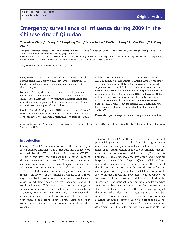摘要
Background
In April, 2009, a new influenza pandemic caused by a swine-origin H1N1 subtype influenza virus was imminent. We thereby carried out an emergency surveillance study in a Chinese city of Qingdao.
Methods
Pharyngeal swab samples were collected from four targeted groups and tested by reverse-transcription polymerase chain reaction. Each laboratory-confirmed pandemic H1N1 case or cluster was investigated, and the hemagglutinin genes of some of the viruses were sequenced and analyzed.
Results
A total of 140 pandemic H1N1 cases including 92 from 7 clusters were identified in the four targeted groups. None of them developed into severe infections. Meanwhile, 103 cases of seasonal influenza (98 H3N2 and 5 H1N1) and 10 clusters of seasonal H3N2 influenza were also identified. Among them, 38 pandemic H1N1 and two seasonal H3N2 influenza cases were air travellers, suggesting that air travel facilitates the spread of pandemic and seasonal influenza even in the northern hemisphere summer. In addition, it was found that pandemic H1N1 and seasonal H3N2 influenza viruses co-circulated in two clusters. No significant mutations were found in the hemagglutinin gene sequences of pandemic H1N1 viruses, but the seasonal H3N2 influenza viruses have become genetically distinguishable from those circulating in 2007-2008.
- 出版日期2011-1
- 单位中国动物卫生与流行病学中心; 山东大学; 山东省青岛市疾病预防控制中心
